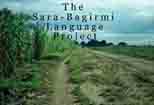|
Project Scope
|
This project is dedicated to the study of the Sara-Bagirmi languages, a group of the
Central Sudanic branch of the Nilo-Saharan languages. They are spoken principally in Chad and
northern Central African Republic. A outline of current information about the languages' geographical
location, distribution, numbers of speakers, and classification can be found with SIL's
Ethnologue. It is often difficult to find all the sources for these languages, and one is
constantly coming across unpublished works -- student theses, missionary works, etc -- for which
it is difficult to find a published reference.
All languages will be additionally identified by their Ethnologue tag, indicated by
square brackets. For example, the Bagirmi language is tagged as [bmi].
|
|
|
Sources
|
Sources for the language data for specific languages is noted with that language.
Most of the information regarding number of speakers and their geographic location has been
taken from Lewis (2009),which we will refer to here as the Ethnologue. Another important
source of data is the College Charles Lwanga in Sarh, which we refer to as CCL.
At present, the project bibliography
is preliminary. We have hopes to be able to revise this in the near future. At some point
we would also like to a brief summary of the works contained in the bibliography.
|
|
|
Project Goals
|
- Gathering existing language data for each of these languages (lexicons, grammatical notes, texts, conversation books, etc.) into the project database.
- Working with a control list, collect from native speakers a minimum of 700 words for each language, each with a sample sentence.
- Record words and sentences with a native speaker, and add the recordings to the language database.
- If possible, use a single system of transcription and a single font for all of the languages. A description of the
writing system used for the Sara Languages is contained in
Transcription for Sara Languages. The transcription for the Sara Kaba and Bagirmi languages will be similar, although there will be some letters (e.g. nasalized vowels) that are not required. Several new letters will also be needed (e.g. the palatal implosive in Kulfa and Bagirmi and the palatal nasal in Bagirmi and Sara Kaba languages)..
- As work progresses, create lexicons (in pdf format) and allow web researchers access to them from this site.
- Edit and print low-cost lexicons for distribution to language groups in Chad. Further, collections of lexicons
will be into volumes that also include an introduction to the language, as well as an introduction to the subgroup
and the language family. (We have currently completed 3 of these volumes:
The Central Sara Languages,
The Eastern Sara Languages, and
The Western Sara Languages).
- Maintain and publish a comparative listing of all the project languages, with access from both French and
English. (The first version of this is now complete for the Sara Languages.)
- Gather a digital version of the language data, including sound files, so that it can be distributed on
DVD's with software that allows a dictionary view of the language in which users can click on words and
sentences to hear them spoken by native speakers.
- To create this web site which we hope to move at some point to a university server from which all of the
language data will be stored, thereby providing long-term security for the data and access to it
for any interested parties. The website will all include all published works as .pdf files.
- Once the website is created, create a web application that permits simple searching of the data for any language based on the French or English word. The word, meanings, sample sentences and expressions will then be returned to the user, together with the sound files, so that the information is accessible from the internet.
|
|
Comments
|
- Language vs. dialects: linguists at times appear to be in a rush to make a determination as to whether
a given speech form is a full-fledged languages or a mere dialect of another language or dialect group. If
one were to use the most common 1,000 words as criteria for such decisions, then we would be forced to conclude
that all Sara Languages are a dialect group of one language. However, when we undertake a comparison of larger
dictionaries, such as the dictionary of Sar and that of Mbay, we find that less than 50% of the words are cognates.
While progress is being made in this area, there are still relatively few languags for which we have more than
1,500 distinct entries. A second problem is the fact that over the past twenty years there has been an important
trend of language merging. In major cities, for example, more precise vocabulary is being dropped in favor of
simpler forms recognized by speakers of other languages or dialects. A major goal of this project is to create larger lexicons and dictionaries of these languages, so that speakers have the resources to relearn lost aspects of their language. The approach taken in this project is to consider all speech forms a language until
we have sufficient data to prove otherwise.
- Writing System vs. Transcription: the system of transcription used in the project is not intended to be a proposal for a writing system.
Rather, it is intended to capture all phonogical distinctions found in each language using a single symbol for each phoneme, with the tone clearly marked.
- Translation language: the web pages and most of the introductions to the language lexicons have been
written in English. The lexicons, with the exception of Mbay, have French translations for the Sara-Bagirmi words and sentences. With the Mbay dictionary, the translations are in English.
|
|

